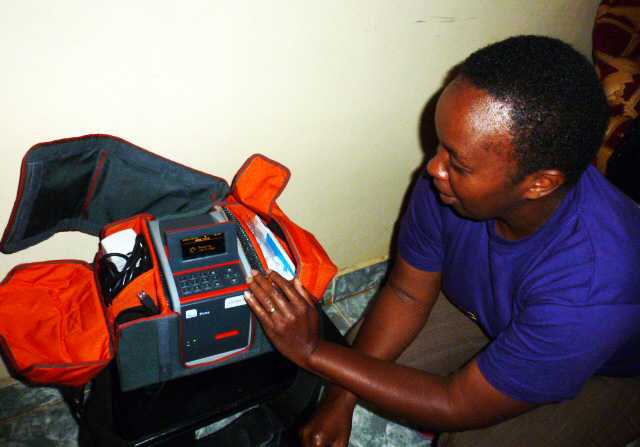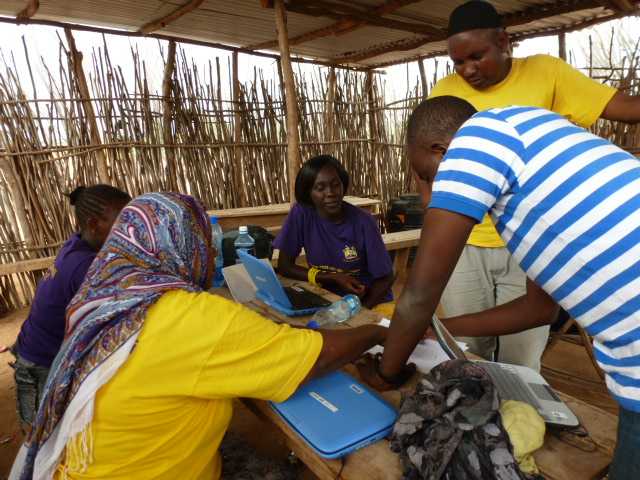Focus, Partner, Achieve: Using Evidence to Achieve an AIDS-Free Generation in Kenya

A youth group performs a skit in which a couple receive their HIV test results during the Kenya AIDS Indicator Survey. The 2012 survey was the first AIDS Indicator Survey to offer home-based counseling and testing, giving participants immediate access to their HIV test results.
Targeted Approach
When PEPFAR was first implemented, its emergency phase brought much-needed drugs, supplies, training, and support for clinics and health care workers to Kenya and other countries.
Since then significant strides have been made in reducing new HIV infections and providing much-needed treatment for persons living with HIV. As of 2013, PEPFAR provided antiretroviral therapy for more than 6.7 million people globally and 631,000 people in Kenya. While this work continues, the needs of partner countries like Kenya have evolved and a more targeted approach to addressing the epidemic is being taken.
Since the launch of the U.S. President’s Emergency Plan for AIDS Relief (PEPFAR) in 2003, CDC has used its expertise in epidemiology and laboratory systems, and its long-standing partnership in public health research in Kenya, to help the country develop more focused HIV interventions that are implemented when, where, and among whom they are needed.
As it works toward achieving an AIDS-Free Generation, one tool that has aided Kenya in making better decisions about its HIV programs is the PEPFAR and CDC-supported Kenya AIDS Indicator Survey (KAIS).
First conducted in 2007 and again in 2012, KAIS was designed to determine the prevalence of HIV in Kenya, identify risk factors for HIV infection, and determine HIV service access and coverage. Data from KAIS has helped Kenya concentrate on where the epidemic is, recognize who is most at risk, and estimate access to and use of HIV prevention, care, and treatment services. This information has aided the government of Kenya in making important decisions about their approach to addressing the country’s HIV epidemic.
Using data to target resources for greatest impact
The final report of the 2012 KAIS survey, released in June 2014, showed that the Nyanza region in western Kenya continued to have a much higher prevalence of HIV than the rest of the country. While the country’s HIV prevalence for adults aged 15-64 years was 5.6%, the prevalence in Nyanza region was 15.1%. Using KAIS data and data from its programs, PEPFAR and the Ministry of Health are now able to target which of the 47 Kenyan counties have the highest burden of HIV and direct resources to where they will have the most impact.

A lab technician performs quality control measures on a machine that analyses CD4 counts from blood specimens collected during the survey.
The prevalence of HIV in Kenya was higher among women than men. Young women aged 20-24 years were three times more likely to be infected (4.6%) than young men of the same age (1.3%). Kenya used KAIS data as a guide to develop its HIV Prevention Revolution Road Map which outlined how it will target young women aged 15-24 for HIV prevention.
In addition to identifying populations at risk, KAIS helped detect trends in HIV program service delivery. From 2007 to 2012, the proportion of adults who stated they had at least one HIV test in their lifetime more than doubled (from 34% to 71%), and the proportion of survey participants who were HIV positive who knew their HIV status almost tripled (from 16% to 47%). This showed progress but, with less than half of HIV positive people knowing their status, more needed to be done. PEPFAR worked with Kenya to develop innovative testing approaches, including implementing provider-initiated testing and counseling, targeting key populations at higher risk for HIV infection, and using rapid response initiatives to focus on geographic areas in need of increased testing services.
The data from KAIS 2012 continued to show that knowledge of HIV status was important to having access to antiretroviral therapy (ART). While 60% of all adults eligible for ART in 2012 were on treatment, among those who knew they were HIV positive and were ART-eligible, almost 85% were on treatment. Treatment access increased from 2007 when only 40% of all ART-eligible adults were on treatment.*
The 2012 KAIS was also the first national survey in Kenya to look at the prevalence of HIV in children aged 18 months to 14 years of age, finding that 0.9% of children in this age group (or about 101,000 children) were HIV infected. However, the survey also showed that less than half (45%) of all children with HIV-infected parents had been tested for HIV. Now, Kenya has increased its efforts to identify children with HIV and ensure that pediatric care and treatment are a priority.

In Garfasa, Kenya, Kenya Medical Research Institute staff provide IT support for netbooks used by interviewers during the Kenya AIDS Indicator Survey.
Updated treatment guidelines
Recently, Kenya issued its revised HIV treatment guidelines, a decision made based on what was learned through the survey, and on research conducted in Kenya and elsewhere which showed that providing treatment reduces transmission of HIV to sexual partners and can reduce transmission of HIV from mother to baby. The updated guidelines are in line with recommendations from the World Health Organization and call for starting treatment earlier for adults, children, and pregnant women.
By addressing the need for evidence-based decision-making, KAIS provided the government of Kenya with the information to best serve its population with improved HIV prevention, care, and treatment services. In addition, by having better targeted programs, CDC and PEPFAR can be more accountable to the American people in how PEPFAR dollars are spent while helping Kenya fulfill its goal of achieving an AIDS-free generation.
Read more about CDC in Kenya.
*Data for 2012 ART-eligibility criterion are based on a CD4 count of less than 350 cells per microliter, while 2007 data was based on a CD4 count of less than 250 cells per microliter, which followed guidelines in effect in their respective years. Based on a CD4 count of <350 cells per microliter, the access in 2007 would have been even lower, at 29%. The revised Kenya guidelines (as of June 2014) increase eligibility to persons with a CD4 count of less than 500 cells per microliter in line with WHO recommendations.
- Page last reviewed: April 25, 2017
- Page last updated: April 25, 2017
- Content source:


 ShareCompartir
ShareCompartir